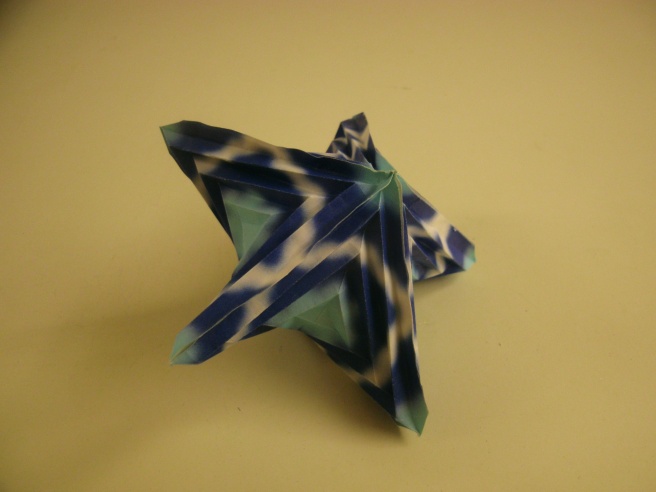Florence Temko; 1981 OUSA (FOCA) Convention / Annual Collection
Grade: B+

This is the sort of elegant, simple model that I expect from this creator. If you like precreasing, this model is for you, since that plus the final collapse is all there is (it’s essentially a series of concentric open sinks). The diagrammed folding method works but is imprecise due to paper thickness, and I came up with a different folding method for all but my first sample. It should be noted that the raw edge has a tendency to ripple; stiffer paper helps control this problem.

Since the entire surface of the paper shows in the finished model, it invites experimentation with interesting papers. I thought that this might be a good choice for those gorgeous, expensive washi prints and chiyogamis that we all buy and then wonder what to fold with them. I was a bit disappointed in the results, though, since the pleating breaks up the print. Note that the model can be folded with either a mountain or valley fold outermost; I think the Wing looks best with mountain folds for the outer fold, as shown in the three larger samples above (the 3″ model is folded “inside out”). I was hoping to get an Op-Art effect from the green concentric-circles paper, but it didn’t quite work. The orange-to-yellow harmony paper looked much better. Duo papers are ideal, since both sides show.

The Module Star is unique. The five modules must be folded with a valley fold outermost to facilitate assembly, as the five units are glued together. The 2″ harmony paper I used for the sample was very prone to edge ripples, and I did a rather messy job of gluing, but it still came out all right, very three-dimensional. Temko mentions that you must “snip” the corners, which is true; I thought they looked best trimmed to points as shown.
You get major attagirls for taking this on, it is an admirable project and I am following with interest.
I don’t know if Florence Temko first created the Wing and Module Star model, but is now widely known as the Hyperbolic Paraboloid and is a subject of much mathematical interest. A circular variation has been explored exhaustively by Erik and Martin Demaine at MIT:
http://erikdemaine.org/curved/history/
LikeLike
Thanks for having a look at my project! Like you, I don’t know whether Florence Temko was the creator or the person who diagrammed it for the Convention book, but the word “hyperbola” certailny came to mind when I folded the first sample. I found the Demaine article very interesting; making those curved creases looks like quite a challenge!
LikeLike